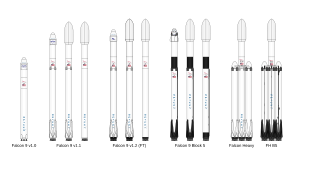 W
WCrewed spacecraft are designed to support human life for the human spaceflight portion of the mission. Spacecraft for human spaceflight must have a human-rating certification as fit for purpose. Crewed spacecraft must have a breathable atmosphere, pressurised ; and be temperature-regulated. Crewed spacecraft include space capsules, spaceplanes, and space stations. This is a list of past, present, and future spacecraft designed for human spaceflight.
 W
WA Falcon 9 first-stage booster is a reusable rocket booster used on the Falcon 9 and Falcon Heavy orbital launch vehicles manufactured by SpaceX. The manufacture of first-stage booster constitutes about 60% of the launch price of a single Falcon 9, which led SpaceX to develop a program dedicated to recovery and reuse of these boosters for a significant decrease in launch costs. After multiple attempts, some as early as 2010, at controlling the reentry of the first stage after its separation from the second stage, the first successful controlled landing of a first stage occurred on 22 December 2015, on the first flight of the Full Thrust version. Since then, Falcon 9 first-stage boosters have been landed and recovered 78 times out of 89 attempts, including synchronized recoveries of the side-boosters of the Falcon Heavy test flight, Arabsat-6A, and STP-2 missions. One out of three Falcon Heavy center boosters landed softly but it was severely damaged during transport.
 W
WThe heaviest artificial objects to reach space include space stations, various upper stages, and discarded Space Shuttle external tanks. Spacecraft may change mass over time such as by use of propellant.
 W
WThis is a list of robotic space probes that have flown by, impacted, orbited or landed on the Moon for the purpose of lunar exploration, as well as probes launched toward the Moon that failed to reach their target.
 W
WThe following table is a list of Mars orbiters, consisting of space probes which were launched from Earth and are currently orbiting Mars. As of February 2021, there have been 18 spacecraft missions operating in Mars' orbit, 8 of which are currently active.
 W
WThis is a list of active space probes which have escaped Earth orbit. It includes lunar space probes, but does not include space probes orbiting at the Sun–Earth Lagrangian points. A craft is deemed "active" if it is still able to transmit usable data to Earth.
 W
WThis list of space telescopes is grouped by major frequency ranges: gamma ray, x-ray, ultraviolet, visible, infrared, microwave and radio. Telescopes that work in multiple frequency bands are included in all of the appropriate sections. Space telescopes that collect particles, such as cosmic ray nuclei and/or electrons, as well as instruments that aim to detect gravitational waves, are also listed. Missions with specific targets within the Solar System, are excluded; see List of Solar System probes for these, and List of Earth observation satellites for missions targeting our planet.